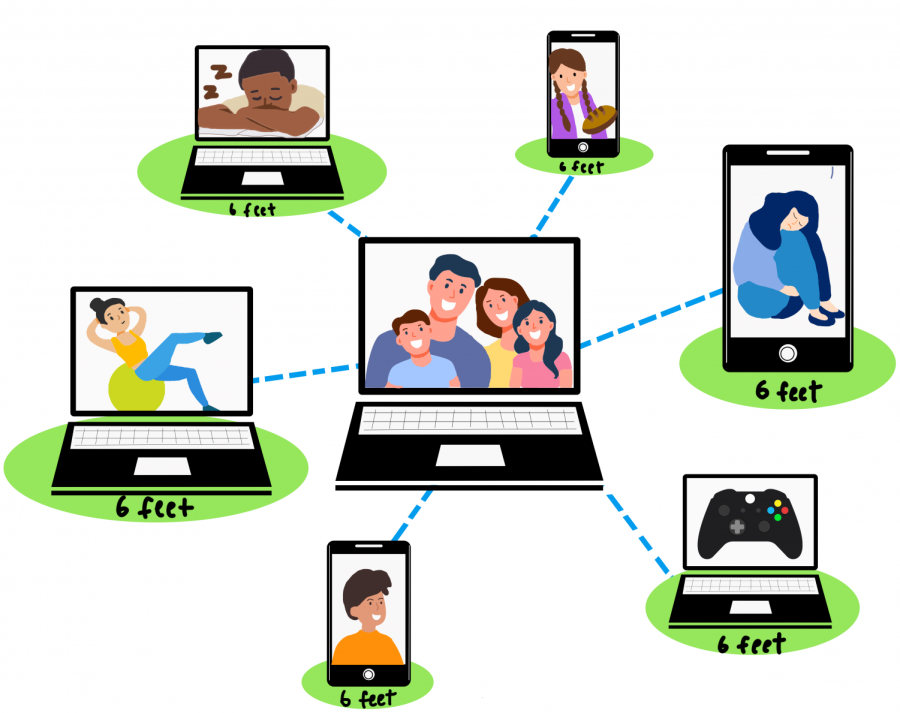Social isolation affects teen social development
Graphic illustration by Sharlene Chen
Computer screens are connected, but not connected at the same time. Some teens fare well at home, but others do not.
August 24, 2020
Isolated, scared and unsure — just a few of the emotions brought on by the COVID-19 pandemic.
Humans are naturally social. With the COVID-19 crisis calling for social distancing, though, teens are getting fewer chances for face-to-face interactions with their friends.
Teenagers are at a stage of life in which they are discovering where they belong. They begin to notice the ways they differ from others and constantly seek groups of people in which they feel accepted. To do so, teens must interact with different kinds of people.
“Erik Erikson, one of the earliest psychologists, thought that the task of adolescence is to break free from your parents and form your own identity,” Lynbrook psychologist Dr. Brittany Stevens said. “So being together with other people your age is important because it allows you to figure out, through trial and error of interacting with different peers, what sort of activity rewards you and what does not.”
Additionally, adolescence is one of the fastest phases of human development, and memories made during this time may last a lifetime. Teens can be affected by social isolation in different ways, varying by temperaments.
“If they’re strong introverts, this may not be a bad time for them,” Licensed Marriage and Family Therapist Christy Hyun said. “I don’t think it’s good for them, but I think they are comfortable. It depends, but if you’re an extrovert, this is torture.”
Regardless of how extroverted they are, teens have turned to technology for their social interaction and entertainment. This is not new. Prior to the pandemic, teens represented the age demographic most connected through the internet, spending nine hours a day using digital technology, according to researchers from the non-profit group Common Sense Media. This number has only grown since the pandemic.
“My screen time has definitely increased, maybe by an hour or two every day,” sophomore Samantha Wong said.
Some even use their screens as an escape from familial tension. Presently, teens have reduced access to extracurricular activities and school responsibilities, adding increased demands of childcare to existing parental concerns, resulting in excessive tension within families.
“There’s a lot of kids who are in abusive homes that may feel very scared because they don’t have anybody to turn to or are not able to go to school,” Hyun said. “Child abuse is up and so is divorce.”
Sheltering-in-place has also made video-calling more popular than ever, since it’s a way to stay safely connected with those not in the same household.
“I get that video-calling is about as close as you can get to in person interaction right now, but it’s still just different,” said sophomore Charlene Guo.
Some have found it much harder to forge connections through a screen because varying environments and internet speeds may lead to inconsistency in the clarity of audio and video communication between parties. Furthermore, with the variety of content available on the internet, video calling can get lost in the overwhelming entertainment options. Video-calling also loses many of the little nuances in human speech and emotion.
“We discount a lot of the body language that we get from being near people,” Stevens said. “Our intuition picks up very quickly what other people feel, and that allows us to very naturally read situations beyond facial expressions.”
Despite these challenges, online meetings have made communication more efficient by eliminating the hassle of factoring travel time into plans.
“This period of time has made us aware that there’s this whole world of online communication with other people,” junior Amy Zhou said. “It’s much easier to spend time together.”
Teens have also been actively interacting through texting, which some find to be more convenient than video-calling or interacting in person. Texting allows people to think for longer periods of time before “speaking” and even lets people take back what they “said,” while maintaining the desired feeling of conversational interaction. When texting, though, emotions and sarcasm can be difficult to detect or convey through a screen, and misunderstandings may interfere with communication.
With most schools turning to remote learning this fall, students no longer have the chance to have conversations while waiting in line, chatting during tutorial or meeting new people in their classes.
“You really miss the table dynamic that you have in in-person school, which is where you get to really interact with the people whom you sit next to instead of talking to profile pictures in breakout rooms,” Zhou said.
Students are now more focused on maintaining their current relationships with closer friends. For distant acquaintances, teens find it harder to strike up a conversation naturally and tend to use social media to stay connected instead.
“This year, because everything is online, you feel less inclined to actually reach out to new people, which I’m bummed about,” junior Angela Hu said. “I feel like people would just text their close friends since they’re not physically in the same place.”
Because schools are using remote learning, many people are concerned about a variety of issues, such as grades or when in-person learning will begin again. One of the biggest concerns is freshmen engagement. Social events such as Homecoming and support groups such as Link Crew are big components of integration and unity at Lynbrook. Without these factors, freshmen are likely most affected socially. Some students offered advice to freshmen:
“Join clubs,” sophomore Shyon Ganguly said. “A lot of the time you are able to interact with people in different ways because clubs have a more personal setting.”
“Engage with your classmates during zoom meetings when your teachers put you into breakout rooms,” Guo said. “Attend any virtual events your class officers may hold.”
“Don’t be afraid to speak up,” said Wong. “Lots of people are afraid to talk to teachers, but once you reach out to them it’s much easier to ask for help.”
“Get to know your teachers,” said Zhou. “We have office hours so many times every week that it’s a great way to get to know who your teachers are.”
Even though it seems COVID-19 quarantine has affected our society negatively, there are some positive sides. Families are forced to be together, therefore having the opportunity to foster cohesive family relationships.
“I’ve definitely grown closer to my family, since we have a lot more time to talk, and we have activities like movie night that we do together,” Hu said.
Families can take advantage of this time to strengthen their bonds.
“Parents have the majority of the influence over kids,” said Hyun. “I see this as an incredible opportunity for parents to really get to know their children.”
People are growing, adapting and becoming more appreciative of things they had previously taken for granted, such as technology and in-person interaction. Moreover, with the extra time from staying at home, they are going outside, trying new hobbies and learning new things.
As the school year progresses, more and more screen time is inevitable. Even so, it’s still important to maintain a positive outlook and participate in as many genuine human interactions as possible, whether that’s online clubs or family activities.
If students are feeling unsafe at home, urges to hurt themselves or others and/or need someone to talk to, they should seek professional help. Students can visit this site for assistance or reach out to Youthline and text teen2teen to 839863 or call 1-877-968-8491. For help with child abuse students can reach out to Childhelp National Child Abuse Hotline at the number 1-800-422-4453.




































































